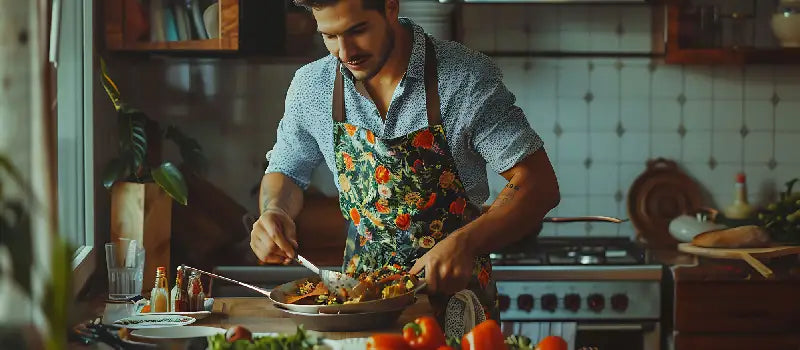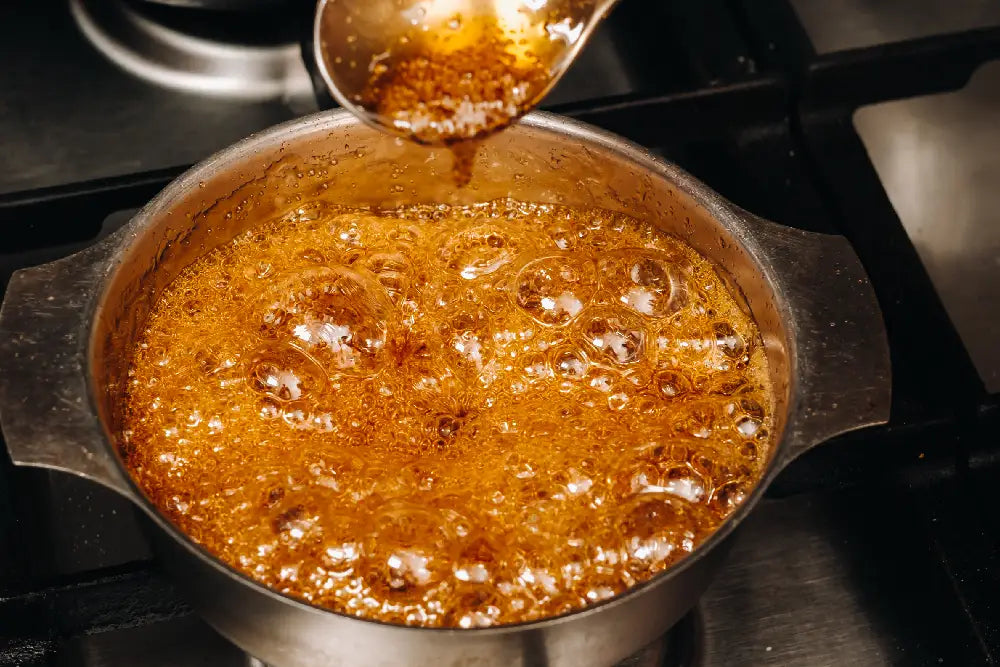
Indian Cooking 101: Complete Guide for Beginners
|
|
Time to read 6 min
What is Indian Cooking?
Indian cooking is more about the heritage, culture, memory, and identity that come from all corners of India. The Indian cuisine thrives on layered flavors, aromatic spices, and diverse techniques. Unlike other cuisines that rely on just a handful of seasonings, Indian meals are built on the art of spice balancing.
A pinch of turmeric for color, cumin for earthiness, ginger for heat, and asafoetida for digestion. Each and every ingredient is intentionally added to the dish.
While all of this may intimidate a beginner who’s just getting into cooking, it’s quite the opposite in reality. What makes the basics of Indian cooking approachable for beginners is its structure:
- A base of onions, tomatoes, ginger, and garlic.
- A spice profile (whole or powdered).
- A main ingredient (vegetables, lentils, or meat).
- A finishing touch with herbs, ghee, or tempering (tadka).
You've got a lot to experiment with. So, if you’re ready to learn to cook Indian food, the journey begins with understanding its regions.
Regional Styles of Indian Cooking
India’s rich diversity is reflected in its food as well, where each region’s food reflects its climate, agriculture, and history. Here’s how cooking Indian food differs across regions:
-

Northern Indian Cooking
Think of butter naan, rich gravies, and the smoky aroma of tandoors. Northern kitchens rely heavily on dairy, including paneer, ghee, and yogurt, to balance their spiced curries. Popular breads like roti, naan, and paratha dominate meals, while tangy touches like amchur (dried mango powder) brighten flavors.
-

Western Indian Cooking
This region is a patchwork: Rajasthan leans on lentils, while Gujarat offers sweet-savory vegetarian dishes. Coastal Goa blends coconut milk with Portuguese-influenced curries like vindaloo. Maharashtra brings rustic breads like bhakri and fiery thecha chutneys.
-

Eastern Indian Cooking
Here, rice and fish form the backbone of meals. Bengali cuisine uses mustard oil, pungent and sharp, giving dishes like shorshe maach (mustard fish curry) their signature kick. Clay cookware is given a preference to ensure gentle and balanced heating.
-

Southern Indian Cooking
If North India is dairy reliant, South India is heavy on coconut usage. Expect idlis, dosa, sambar, rasam, all rice-based. Tamarind adds tang, while coconut (milk, oil, or grated) balances heat. Cooking vessels like the cast-iron tawa or clay chatti remain central to the region’s authenticity.
Indian Cooking Equipment (Essential Tools)
Before diving into recipes, equip your kitchen with the right tools. A well-prepped kitchen makes learning Indian cooking so much easier. Here’s a list of everything you need:

Tawa
A flat, concave griddle used for rotis, parathas, dosas, and reheating.

Kadhai (Karahi)
Deep wok-like pan ideal for frying, sautéing, and cooking curries.

Handi
Traditional clay/metal pot for biryanis and slow-cooked dishes.

Chakla-Belan
Rolling board and pin for preparing flatbreads.

Mortar & Pestle (Sil Batta)
Rolling board and pin for preparing flatbreads.

Spice Box (Masala Dabba)
Keeps daily spices handy in one container.

Pressure Cooker
Speeds up the cooking of dals, rice, and curries.

Strainer (Chhanni)
For smooth dals and gravies.

Other Tools
Tadka pan, idli stand, chutney grinder, heavy-bottomed pots.
Shopping List for Basic Indian Ingredients (Beginner-Friendly)
To learn to cook Indian food, you need to get the right ingredients. We are here to simplify your process by giving you a list of ingredients from which you can start cooking basic Indian everyday meals:
Spices
- Turmeric Powder | Haldi Powder (हल्दी)
- Red Chili Powder | Lal Mirch Powder (लाल मिर्च)
- Coriander Powder | Dhaniya Powder (धनिया पाउडर)
- Cumin Seeds/Powder | Jeera Powder (जीरा)
- Garam Masala | Garam Masala (गरम मसाला)
- Salt | Namak (नमक)
Dry Goods
- Basmati Rice | Basmati Chawal (बासमती चावल)
- Whole Wheat Flour | Gehun ka Atta (गेहूं का आटा)
- Split Pigeon Peas | Arhar/Toor Dal (अरहर दाल)
- Yellow Lentils | Moong Dal (मूंग दाल)
- Red Lentils | Masoor Dal (मसूर दाल)
Oils & Fats
- Vegetable Oil | Tel (तेल)
- Ghee | Ghee (घी)
Herbs
- Coriander Leaves | Hara Dhaniya (हरा धनिया)
- Curry Leaves | Kari Patta (करी पत्ता)
Aromatics
- Onion | Pyaz (प्याज)
- Tomato | Tamatar (टमाटर)
- Garlic | Lahsun (लहसुन)
- Ginger | Adrak (अदरक)
- Green Chilies | Hari Mirch (हरी मिर्च)
Traditional Pantry Staples in Indian Cuisine
Once you’ve mastered the basics and moved beyond beginner level, your confidence will grow, and so should your pantry stock! This is the time to explore authentic spices and staples that bring depth and versatility. Here are some traditional staples you will need in your kitchen to cook delicious Indian food:
Spices
- Mustard Seeds | Rai/Sarson (राई/सरसों)
- Fennel Seeds | Saunf (सौंफ)
- Fenugreek Seeds | Methi Dana (मेथी दाना)
- Cardamom (Green/Black) | Chhoti Elaichi/Badi Elaichi (छोटी/बड़ी इलायची)
- Cloves | Laung (लौंग)
- Cinnamon | Dalchini (दालचीनी)
- Bay Leaves | Tej Patta (तेज पत्ता)
- Mace & Nutmeg | Javitri/Jaiphal (जावित्री/जायफल)
- Dry Red Chilies | Sukhi Lal Mirch (सूखी लाल मिर्च)
- Asafoetida | Hing (हींग)
- Nigella Seeds | Kalonji (कलौंजी)
- Star Anise | Chakri Phool (चक्र फूल)
- Saffron | Kesar (केसर)
Pulses & Grains
- Split Chickpea Lentils | Chana Dal (चना दाल)
- Black Lentils | Urad Dal (उड़द दाल)
- Chickpeas | Kabuli Chana (काबुली चना)
- Kidney Beans | Rajma (राजमा)
- Flattened Rice | Poha (पोहा)
- Semolina | Sooji/Rava (सूजी/रवा)
Flours
- Gram Flour | Besan (बेसन)
- Rice Flour | Chawal ka Atta (चावल का आटा)
Oils & Condiments
- Mustard Oil | Sarson ka Tel (सरसों का तेल)
- Coconut Oil | Nariyal ka Tel (नारियल का तेल)
- Tamarind Paste | Imli ka Paste (इमली का पेस्ट)
- Jaggery | Gur (गुड़)
Other Staples
- Yogurt/Curd | Dahi (दही)
- Cottage Cheese | Paneer (पनीर)
- Pickles | Achar (अचार)
- Poppadom/Papadam | Papad (पापड़)
Techniques for Indian Cooking
The basics of Indian cooking lie in mastering spice selection and cooking techniques. Here are some techniques to be familiar with:

Tempering (Tadka)
Crackling spices in hot oil for flavor.

Bhunao (Sautéing)
Slow-cooking onions/spices till golden.

Dum (Slow Cooking)
Sealed pot cooking for biryani/curries.

Dhungar (Smoking)
Adding smoky flavor with coal.

Tandoori/Grilling
High heat for smoky bread, meats, and some high-protein gravies.

Steaming
Idlis, dhoklas, modaks.

Pickling (Balchao)
Preserving with spices and oil.

Roasting
Dry-toasting spices for depth.

Pressure Cooking
Speeds up dals/rice.

Fermentation
For dosa/idli batter.
Best Indian Dishes to Try
No Indian cooking guide is complete without a list of the best dishes to try! Here’s our list:

Butter Chicken
Why It’s SpecialA flat, concave griddle used for rotis, parathas, dosas, and reheating.
Best Paired WithNaan or roti

Dal Makhani
Why It’s SpecialSlow-cooked black dal & kidney beans.
Best Paired WithJeera rice or roti

Chole Bhature
Why It’s SpecialSpicy chickpeas + fluffy fried bread.
Best Paired WithBhature or roti

Biryani
Why It’s SpecialFragrant rice with spices/meat.
Best Paired WithRaita & papad

Rogan Josh
Why It’s SpecialKashmiri lamb curry, red chili warmth.
Best Paired WithNaan or rice

Masala Dosa
Why It’s SpecialCrispy rice crepe with potato masala.
Best Paired WithCoconut chutney & sambar

Pani Puri
Why It’s SpecialTangy street snack explosion.
Best Paired WithJust itself!

Palak Paneer
Why It’s SpecialPaneer in spinach gravy.
Best Paired WithPhulkas or naan

Hyderabadi Haleem
Why It’s SpecialSlow-cooked meat & lentil stew.
Best Paired WithNaan or paratha

Gulab Jamun
Why It’s SpecialSyrup-soaked dessert.
Best Paired WithRabri, kulfi, or vanilla ice cream
Explore our curated list of What to Eat With Roti.
Don’t Miss Indian Breads
Flatbreads are at the heart of Indian cooking. From everyday chapatis and rotis to parathas, naans, kulchas, and bhature, these breads form the foundation of Indian meals. And you don’t have to worry about spending more time in the kitchen to perfect the art of making Indian flatbreads when you have Rotimatic by your side!

Indian cooking isn’t about mastering everything in one day. It’s about small steps, like stocking your pantry, learning a technique, trying a dish, and then slowly creating food that feels home-like. And with modern tools like Rotimatic, the journey becomes simpler, faster, and a lot more fun!